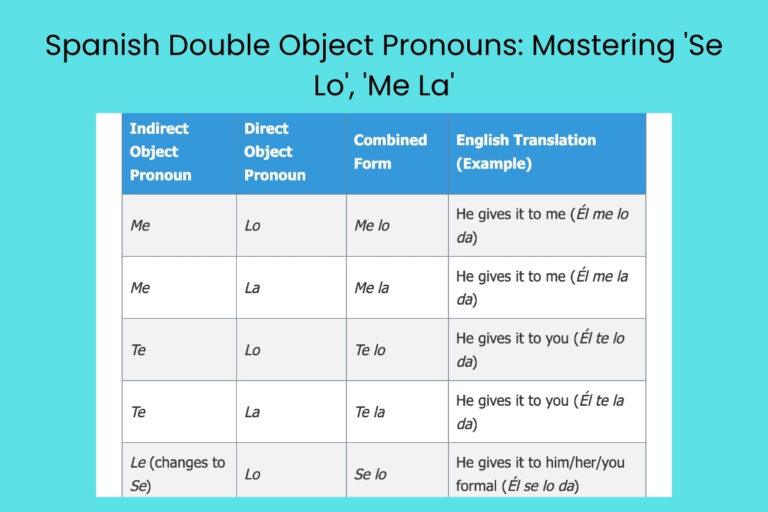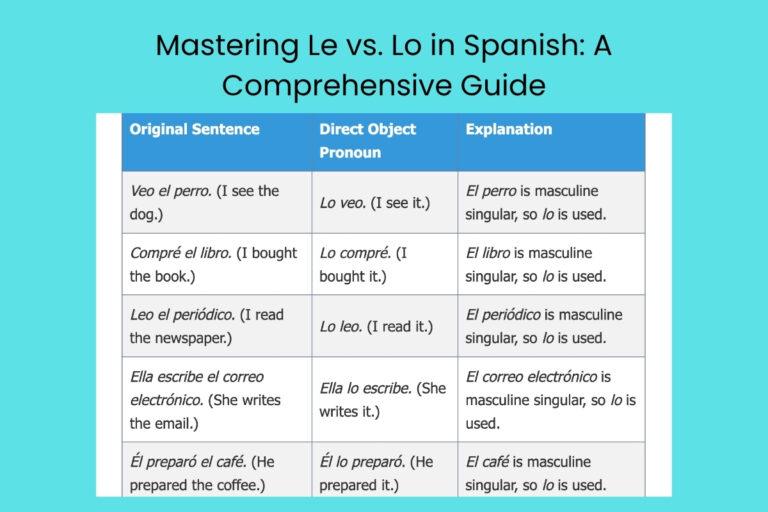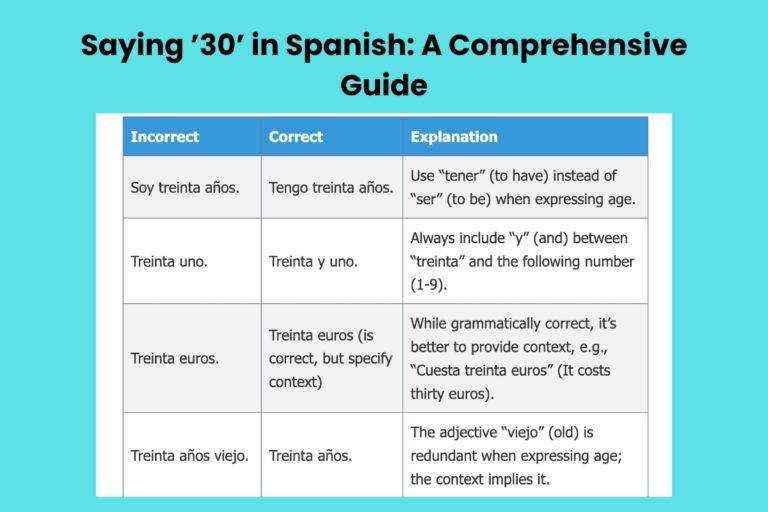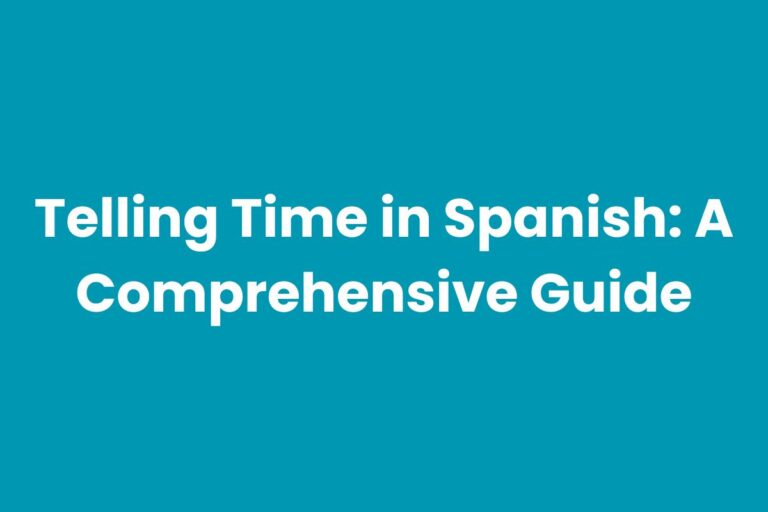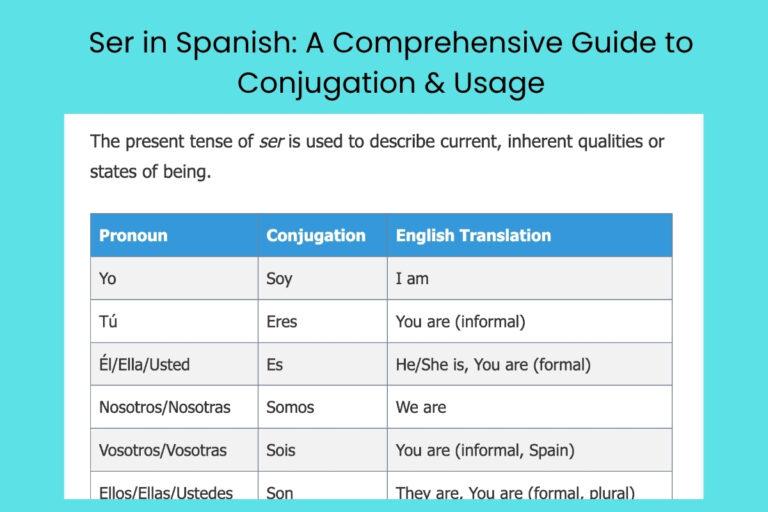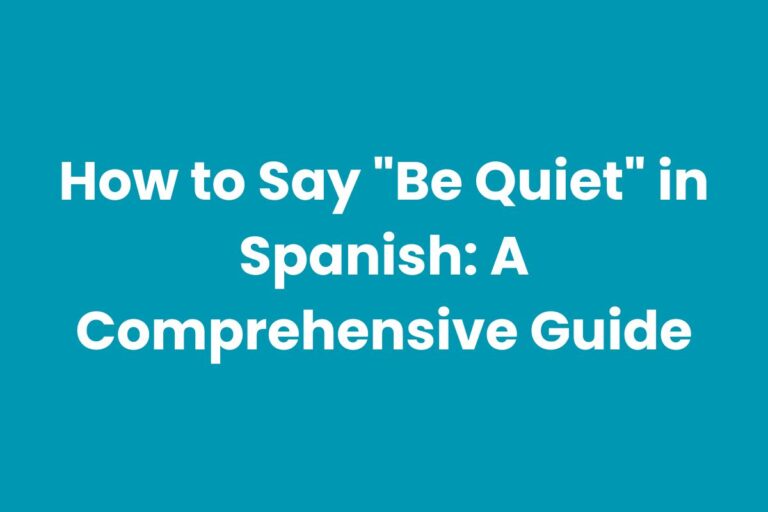Spanish Gerund vs. Infinitive: A Comprehensive Guide
Mastering the nuances between the Spanish gerund and infinitive is crucial for achieving fluency and accuracy in Spanish. These verb forms, while seemingly interchangeable at times, have distinct functions and usages.
Understanding when to use each form correctly will significantly improve your ability to express yourself clearly and avoid common grammatical errors. This guide is designed for Spanish learners of all levels, from beginners seeking a solid foundation to advanced students aiming to refine their understanding of Spanish grammar.
By exploring definitions, structural breakdowns, examples, and practice exercises, you will gain a comprehensive understanding of the gerund and infinitive in Spanish.
Table of Contents
- Introduction
- Definitions: Gerund and Infinitive
- Structural Breakdown
- Usage Rules
- Examples of Gerund and Infinitive
- Common Mistakes
- Practice Exercises
- Advanced Topics
- FAQ
- Conclusion
Definitions: Gerund and Infinitive
The Gerund (El Gerundio)
The gerund in Spanish, known as el gerundio, is a non-finite verb form that expresses an action in progress. It’s equivalent to the English “-ing” form of a verb (e.g., “running,” “eating,” “writing”). The Spanish gerund is invariable, meaning it doesn’t change its form to agree with gender or number. Its primary function is to act as an adverb, modifying the verb and describing how the action is being performed. The gerund always indicates an action that is happening simultaneously with or immediately before the main verb.
Think of the gerund as painting a picture of an ongoing action. It adds detail and context to the primary verb, providing information about the manner or circumstances surrounding the action.
The Spanish gerund can never function as a noun, unlike its English counterpart.
The Infinitive (El Infinitivo)
The infinitive (el infinitivo) is the base form of a verb in Spanish. It’s the form you see listed in dictionaries. Spanish infinitives end in one of three suffixes: -ar, -er, or -ir (e.g., hablar [to speak], comer [to eat], vivir [to live]). The infinitive can function as a noun, adjective, or adverb, depending on the context. It often expresses the general idea of an action without specifying who is performing it or when it is happening. The infinitive is essential for verb conjugations and forming various verb tenses and moods. It is also used after prepositions and certain verbs.
Consider the infinitive as the raw, unadulterated form of the verb. It’s the potential for action, the blueprint before anything is built.
The infinitive is a versatile building block in Spanish grammar, capable of playing multiple roles within a sentence.
Structural Breakdown
Gerund Formation
Forming the gerund in Spanish is relatively straightforward. Here’s how:
- For -ar verbs: Remove the -ar ending and add -ando.
- Hablar (to speak) → Hablando (speaking)
- Cantar (to sing) → Cantando (singing)
- For -er and -ir verbs: Remove the -er or -ir ending and add -iendo.
- Comer (to eat) → Comiendo (eating)
- Vivir (to live) → Viviendo (living)
There are, however, some irregular gerunds, particularly those involving stem changes:
- Stem-changing -ir verbs (e → ie): The e in the stem changes to i.
- Sentir (to feel) → Sintiendo (feeling)
- Mentir (to lie) → Mintiendo (lying)
- Stem-changing -ir verbs (e → i): The e in the stem changes to i.
- Servir (to serve) → Sirviendo (serving)
- Pedir (to ask for) → Pidiendo (asking for)
- Stem-changing -ir verbs (o → ue): The o in the stem changes to u. This is less common.
- Dormir (to sleep) → Durmiendo (sleeping)
- Verbs ending in -aer, -eer, or -uir: These verbs change the -iendo ending to -yendo.
- Leer (to read) → Leyendo (reading)
- Construir (to construct) → Construyendo (constructing)
Infinitive Forms
The infinitive is the most basic form of the verb. As mentioned earlier, Spanish infinitives always end in -ar, -er, or -ir. There are no structural changes to memorize; you simply use the infinitive as it is. The challenge lies in understanding when and how to use it correctly.
Examples include:
- Amar (to love)
- Temer (to fear)
- Partir (to leave)
Usage Rules
Gerund Usage
The gerund is primarily used in the following ways:
- To form progressive tenses: This is its most common use. It’s used with the auxiliary verb estar to indicate an ongoing action.
- Estoy comiendo. (I am eating.)
- Estábamos hablando. (We were talking.)
- To describe how an action is performed: The gerund can function as an adverb, modifying the verb.
- Llegó corriendo. (He arrived running.)
- Lo aprendí leyendo. (I learned it by reading.)
- To indicate simultaneous actions: The gerund describes an action that is happening at the same time as the main verb.
- Escucho música trabajando. (I listen to music while working.)
- Estudiaba escuchando la radio. (I used to study listening to the radio.)
Important Restrictions:
- The gerund cannot be used to describe a future action.
- The gerund cannot be used as a noun.
- Avoid using the gerund to describe a consequence of an action. Use a different construction for that (e.g., a relative clause).
Infinitive Usage
The infinitive has a wider range of uses:
- As the subject of a sentence:
- Fumar es malo para la salud. (Smoking is bad for your health.)
- Viajar es mi pasión. (Traveling is my passion.)
- After prepositions:
- Después de comer, vamos al cine. (After eating, we go to the cinema.)
- Antes de salir, cierra la puerta. (Before leaving, close the door.)
- As a complement after certain verbs: Many verbs require an infinitive to complete their meaning.
- Quiero viajar. (I want to travel.)
- Necesito estudiar. (I need to study.)
- With modal verbs: Modal verbs are always followed by an infinitive.
- Puedo cantar. (I can sing.)
- Debemos estudiar. (We should study.)
- In impersonal expressions:
- Es necesario estudiar. (It is necessary to study.)
- Es importante ser puntual. (It is important to be punctual.)
Examples of Gerund and Infinitive
Gerund Examples
Here are several examples of the gerund in action:
| Spanish Sentence | English Translation |
|---|---|
| Estoy escribiendo una carta. | I am writing a letter. |
| Ella está cantando en la ducha. | She is singing in the shower. |
| Estamos comiendo pizza. | We are eating pizza. |
| Ellos están durmiendo. | They are sleeping. |
| El gato está jugando con la lana. | The cat is playing with the yarn. |
| Aprendí a nadar viendo a mi hermano. | I learned to swim by watching my brother. |
| Llegó gritando mi nombre. | He arrived shouting my name. |
| Se cayó corriendo. | He fell while running. |
| Trabajo escuchando música. | I work listening to music. |
| Estudio tomando apuntes. | I study taking notes. |
| Sigo pensando en ti. | I keep thinking about you. |
| Vamos caminando al parque. | We are walking to the park. |
| El avión va volando muy alto. | The plane is flying very high. |
| La niña sigue llorando. | The girl keeps crying. |
| El perro andaba buscando su hueso. | The dog was looking for his bone. |
| Voy mejorando mi español. | I am improving my Spanish. |
| Estaba lloviendo cuando salí. | It was raining when I left. |
| Continúan construyendo el edificio. | They continue building the building. |
| Pasé la tarde leyendo. | I spent the afternoon reading. |
| El volcán sigue ardiendo. | The volcano keeps burning. |
| Se gana la vida escribiendo novelas. | He earns a living writing novels. |
| Estamos celebrando su cumpleaños. | We are celebrating his birthday. |
| Subí la montaña caminando. | I climbed the mountain by walking. |
| Bajé las escaleras corriendo. | I went down the stairs running. |
| Me fui sintiendo mejor. | I left feeling better. |
| La vi saliendo del cine. | I saw her leaving the cinema. |
This table showcases the gerund in various contexts, highlighting its role in progressive tenses and as an adverbial modifier.
Infinitive Examples
Now, let’s look at examples of the infinitive:
| Spanish Sentence | English Translation |
|---|---|
| Es importante estudiar. | It is important to study. |
| Quiero comer. | I want to eat. |
| Necesito dormir. | I need to sleep. |
| Puedo cantar. | I can sing. |
| Debemos aprender. | We should learn. |
| Fumar es malo. | Smoking is bad. |
| Viajar es divertido. | Traveling is fun. |
| Después de comer, vamos al cine. | After eating, we go to the cinema. |
| Antes de salir, cierra la puerta. | Before leaving, close the door. |
| Para aprender, hay que practicar. | To learn, you have to practice. |
| Me gusta bailar. | I like to dance. |
| Prefiero leer. | I prefer to read. |
| Tengo que trabajar. | I have to work. |
| Hay que ser paciente. | One must be patient. |
| Es un placer conocerte. | It’s a pleasure to meet you. |
| Es difícil entender. | It’s difficult to understand. |
| Intento escribir todos los días. | I try to write every day. |
| Decidí estudiar español. | I decided to study Spanish. |
| Espero verte pronto. | I hope to see you soon. |
| Prometo ayudarte. | I promise to help you. |
| Olvidé comprar pan. | I forgot to buy bread. |
| Recuerdo haber visto esa película. | I remember having seen that movie. |
| Dejé de fumar. | I stopped smoking. |
| Evito comer dulces. | I avoid eating sweets. |
| Siempre trato de ser amable. | I always try to be kind. |
| Sueño con viajar por el mundo. | I dream of traveling the world. |
This table demonstrates the versatility of the infinitive, showcasing its use as a subject, after prepositions, and after certain verbs.
| Spanish Sentence | English Translation |
|---|---|
| Antes de hablar, piensa. | Before speaking, think. |
| Después de cenar, vemos una película. | After having dinner, we watch a movie. |
| Sin pensar, actuó. | Without thinking, he acted. |
| Para vivir bien, come sano. | To live well, eat healthy. |
| Por estudiar tanto, se cansó. | For studying so much, he got tired. |
| A pesar de ser difícil, lo intentó. | Despite being difficult, he tried. |
| En vez de quejarse, trabaja. | Instead of complaining, work. |
| Además de cantar, baila. | Besides singing, she dances. |
| Acerca de escribir la carta, ya la terminé. | About writing the letter, I already finished it. |
| Cerca de terminar, me llamaron. | Close to finishing, they called me. |
| Con el fin de aprender, estudio. | In order to learn, I study. |
| Lejos de olvidar, recuerdo todo. | Far from forgetting, I remember everything. |
| A fuerza de practicar, lo logró. | By dint of practicing, he achieved it. |
| Camino a casa, me encontré con María. | On the way home, I met María. |
| De tanto insistir, lo convencí. | By insisting so much, I convinced him. |
| Desde mi punto de vista, es importante. | From my point of view, it’s important. |
| En cuanto a terminar el proyecto, estoy trabajando en ello. | As for finishing the project, I am working on it. |
| Frente a firmar el contrato, lo voy a leer. | Before signing the contract, I am going to read it. |
| Gracias a estudiar, aprobé. | Thanks to studying, I passed. |
| Junto con leer, escribo. | Along with reading, I write. |
| Por miedo a fallar, no lo intentó. | For fear of failing, he didn’t try. |
| Rumbo a casa, compré pan. | On the way home, I bought bread. |
| Tras pensar mucho, decidí. | After thinking a lot, I decided. |
| Vía estudiar, aprendí. | By studying, I learned. |
| Según decir, va a llover. | According to what they say, it is going to rain. |
| Con tal de aprobar, estudiaré mucho. | In order to pass, I will study a lot. |
This table specifically highlights the use of infinitives after prepositions, showcasing a variety of prepositional phrases commonly used in Spanish.
Common Mistakes
One frequent error is using the gerund to describe a result or consequence. For example:
- Incorrect: Estudié mucho, *obteniendo* una buena nota. (I studied a lot, obtaining a good grade.)
- Correct: Estudié mucho y *obtuve* una buena nota. (I studied a lot and I obtained a good grade.) OR Estudié mucho, *por lo que obtuve* una buena nota. (I studied a lot, therefore I obtained a good grade.)
Another common mistake involves using the gerund to express a future action:
- Incorrect: Estaré *viajando* mañana. (I will be traveling tomorrow.)
- Correct: Viajaré mañana. (I will travel tomorrow.) OR Estaré de viaje mañana. (I will be traveling tomorrow – alternative phrasing.)
Confusing when to use the infinitive after certain verbs is also a common issue. Remember that some verbs require a preposition (like a or de) before the infinitive, while others don’t.
- Correct: Aprendí a nadar. (I learned to swim.)
- Incorrect: Aprendí nadar.
- Correct: Quiero comer. (I want to eat.)
- Incorrect: Quiero a comer.
Practice Exercises
Exercise 1: Gerund or Infinitive?
Choose the correct form, gerund or infinitive, to complete each sentence.
| Sentence | Correct Answer |
|---|---|
| 1. Estoy ________ (leer) un libro interesante. | leyendo |
| 2. Quiero ________ (aprender) español. | aprender |
| 3. Ella llegó ________ (cantar). | cantando |
| 4. Es importante ________ (estudiar). | estudiar |
| 5. Sigo ________ (pensar) en ti. | pensando |
| 6. Necesito ________ (dormir) más. | dormir |
| 7. Vamos ________ (caminar) al parque. | caminando |
| 8. Antes de ________ (salir), cierra la puerta. | salir |
| 9. El niño está ________ (jugar) con sus juguetes. | jugando |
| 10. Me gusta ________ (bailar). | bailar |
Exercise 2: Sentence Completion
Complete the following sentences using the gerund or infinitive form of the verb in parentheses.
| Sentence | Correct Answer |
|---|---|
| 1. Después de ________ (comer), me siento satisfecho. | comer |
| 2. Estoy ________ (escribir) un correo electrónico. | escribiendo |
| 3. Prefiero ________ (leer) novelas a ver televisión. | leer |
| 4. El bebé sigue ________ (llorar). | llorando |
| 5. Tengo que ________ (trabajar) para ganar dinero. | trabajar |
| 6. Ella está ________ (estudiar) para el examen. | estudiando |
| 7. Es necesario ________ (ser) puntual. | ser |
| 8. Lo aprendí ________ (leer) libros. | leyendo |
| 9. Puedo ________ (hablar) español. | hablar |
| 10. Evito ________ (comer) comida rápida. | comer |
Advanced Topics
Progressive Tenses
Beyond the present progressive (estar + gerundio), Spanish also has other progressive tenses that use the gerundio. For example, the imperfect progressive (estaba + gerundio) describes an ongoing action in the past. Similarly, the preterite progressive (estuve + gerundio) indicates an action that was in progress at a specific point in the past. The future progressive (estaré + gerundio) describes an action that will be in progress in the future. Recognizing and using these tenses correctly will add depth and nuance to your Spanish.
Examples:
- Estaba leyendo cuando llamaste. (I was reading when you called.)
- Estuve trabajando toda la noche. (I was working all night.)
- Estaré viajando la semana que viene. (I will be traveling next week.)
Infinitive Clauses
Infinitive clauses can function as noun clauses, adjective clauses, or adverbial clauses. When an infinitive clause acts as a noun clause, it can be the subject or object of a verb.
When it acts as an adjective clause, it modifies a noun. When it acts as an adverbial clause, it modifies a verb, adjective, or adverb.
Understanding these different functions is key to mastering complex sentence structures in Spanish.
Examples:
- Me gusta leer libros. (I like to read books.) – Infinitive clause as object.
- El deseo de viajar es fuerte. (The desire to travel is strong.) – Infinitive clause as adjective modifying “deseo”.
- Para aprobar el examen, debes estudiar mucho. (In order to pass the exam, you must study a lot.) – Infinitive clause as adverb modifying “debes estudiar”.
FAQ
- What is the difference between the Spanish gerund and the English gerund?
While both express ongoing actions, the Spanish gerund functions primarily as an adverb, while the English gerund can also function as a noun. For example, “Swimming is fun” uses the English gerund as a noun, which cannot be directly translated using the Spanish gerund. Instead, you would say “Nadar es divertido,” using the infinitive.
- Can the Spanish gerund be used with any verb?
The gerund is most commonly used with the verb estar to form progressive tenses. However, it can also be used with other verbs to describe how an action is performed. It’s important to ensure that the gerund describes an action happening simultaneously with the main verb.
- When should I use the infinitive instead of the gerund?
Use the infinitive when you need the base form of the verb, such as after prepositions, modal verbs, or when the verb acts as a noun. The gerund is used specifically to describe an ongoing action, often in conjunction with the verb estar.
- Are there any verbs that always require an infinitive after them?
Yes, many verbs require an infinitive. Common examples include querer (to want), necesitar (to need), poder (to be able to), deber (should), intentar (to try), and decidir (to decide). There are many more, and learning these verbs is crucial for correct usage.
- How do I know when to use a preposition before an infinitive?
Some verbs require a preposition (like a or de) before the infinitive, while others don’t. This often depends on the specific verb and its meaning. For example, “aprender a nadar” (to learn to swim) requires the preposition “a,” while “querer comer” (to want to eat) does not. It’s best to learn these combinations as you encounter them.
- What are some common irregular gerunds?
Irregular gerunds often involve stem changes, particularly in -ir verbs. For example, sentir becomes sintiendo, dormir becomes durmiendo, and verbs ending in -aer, -eer, or -uir change -iendo to -yendo (e.g., leer becomes leyendo).
- Can I use the gerund to describe a characteristic of a person or thing?
No, the gerund should not be used to describe a characteristic. It describes an action in progress. For example, you wouldn’t say “*Es una persona hablando mucho*” to describe a talkative person. Instead, you would say “Es una persona que habla mucho” or “Es una persona habladora.”
- Is there a difference in meaning between “Estoy leyendo” and “Leo“?
Yes, “Estoy leyendo” (I am reading) emphasizes that the action is happening right now, at this moment. “Leo” (I read) is a more general statement and can refer to a habitual action or a general ability to read. The progressive tense highlights the ongoing nature of the action.
- Can I use the infinitive after all prepositions?
Generally, yes. The infinitive is commonly used after prepositions like a, de, en, para, por, sin, antes de, and después de. However, the specific meaning and context will determine whether the infinitive is the appropriate choice.
- How can I improve my ability to use the gerund and infinitive correctly?
Practice is key! Pay attention to how native speakers use these verb forms in speech and writing. Do exercises that require you to choose between the gerund and the infinitive. Read Spanish texts and identify examples of both forms. The more you expose yourself to the language and actively practice using these verb forms, the better you will become at using them correctly.
Conclusion
Understanding the distinction between the Spanish gerund and infinitive is paramount for mastering Spanish grammar. The gerund, with its focus on ongoing actions, and the infinitive, with its versatility as a noun, adjective, or adverb, each play vital roles in constructing meaningful sentences.
By studying the rules, examples, and common mistakes outlined in this guide, you can confidently navigate the complexities of these verb forms. Regular practice and exposure to the language will further solidify your understanding and improve your fluency.
Remember to focus on the context and the intended meaning to choose the correct form.
Continue to practice and explore the nuances of Spanish grammar. With dedication and the right resources, you can achieve fluency and express yourself with confidence.
Embrace the challenges, and enjoy the journey of learning Spanish.


